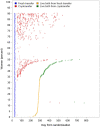Conventional outcome reporting per IVF cycle/embryo transfer may systematically underestimate chances of success for women undergoing ART: relevant biases in registries, epidemiological studies, and guidelines
- PMID: 37250429
- PMCID: PMC10214861
- DOI: 10.1093/hropen/hoad018
Conventional outcome reporting per IVF cycle/embryo transfer may systematically underestimate chances of success for women undergoing ART: relevant biases in registries, epidemiological studies, and guidelines
Abstract
Pre-conception counselling and management of expectations about chance of success of IVF/ICSI treatments is an integral part of fertility care. Registry data are usually used to inform patients about expected success rates of IVF/ICSI treatment, as these data should best represent real-world populations and clinical practice. In registries, the success rate of IVF/ICSI treatments is conventionally reported per treatment cycle or per embryo transfer and estimated from data for which several treatment attempts per subject have been pooled (e.g. repetitive IVF/ICSI attempts or repetitive attempts of cryotransfer). This, however, may underestimate the true mean chance of success per treatment attempt, because treatment attempts of women with a poor prognosis will usually be over-represented in a pool of treatment cycle data compared to treatment events of women with a good prognosis. Of note, this phenomenon is also a source of potential bias when comparing outcomes between fresh transfers and cryotransfers, since women can undergo a maximum of only one fresh transfer after each IVF/ICSI treatment, but potentially several cryotransfers. Herein, we use a trial dataset from 619 women, who underwent one cycle of ovarian stimulation and ICSI, a Day 5 fresh transfer and/or subsequent cryotransfers (follow-up of all cryotransfers up to 1 year after the start of stimulation), to exemplify the underestimation of the live birth rate, when not accounting for repeated transfers in the same woman. Using mixed-effect logistic regression modelling, we show that the mean live birth rate per transfer per woman in cryocycles is underestimated by the factor 0.69 (e.g. live birth rate per cryotransfer of 36% after adjustment versus 25% unadjusted). We conclude that the average chance of success of treatment cycles of women of a given age, treated in a given centre, etc., when conventionally calculated per cycle or per embryo transfer from a pool of treatment events, do not apply to an individual woman. We suggest that patients are, especially at the outset of treatment, systematically confronted with mean estimates of success per attempt that are too low. Live birth rates per transfer from datasets encompassing multiple transfers from single individuals could be more accurately reported using statistical models accounting for the correlation between cycle outcomes within women.
Keywords: IVF outcome; IVF registry; IVF success; embryo transfer; pregnancy rate.
© The Author(s) 2023. Published by Oxford University Press on behalf of European Society of Human Reproduction and Embryology.
Conflict of interest statement
G.G. received no financial support for the research, authorship, and/or publication of this article. G.G. has, outside from this work, received honoraria and/or non-financial support (e.g. travel cost compensation) from Abbott, Ferring, Gedeon Richter, Guerbet, Merck, Organon, MSD, ObsEva, PregLem, ReprodWissen GmbH, Vifor and Cooper. P.L. is an employee of Ferring Pharmaceuticals.
Figures



References
-
- Adamson GD, De Mouzon J, Chambers GM, Zegers-Hochschild F, Mansour R, Ishihara O, Banker M, Dyer S.. International Committee for Monitoring Assisted Reproductive Technology: world report on assisted reproductive technology, 2011. Fertil Steril 2018;110:1067–1080. - PubMed
-
- Bartnitzky S, Blumenauer V, Czeromin U, Fehr D, Gnoth C, Grewe C, Krüssel J-S, Kupka MS, Tandler-Schneider A, Tauchert S.. D·I·R Annual 2020—the German IVF-Registry. J Reprod Med Endocrinol 2021;18:204–247.
-
- Bosdou JK, Venetis CA, Tarlatzis BC, Grimbizis GF, Kolibianakis EM.. Higher probability of live-birth in high, but not normal, responders after first frozen-embryo transfer in a freeze-only cycle strategy compared to fresh-embryo transfer: a meta-analysis. Hum Reprod 2019;34:491–505. - PubMed
-
- CDC. How to Access and Interpret Fertility Clinic Success Rates. Centers for Disease Control and Prevention, 2021. Available at: https://www.cdc.gov/art/reports/2019/how-to-access-interpret.html (May 2023, date last accessed).
LinkOut - more resources
Full Text Sources
